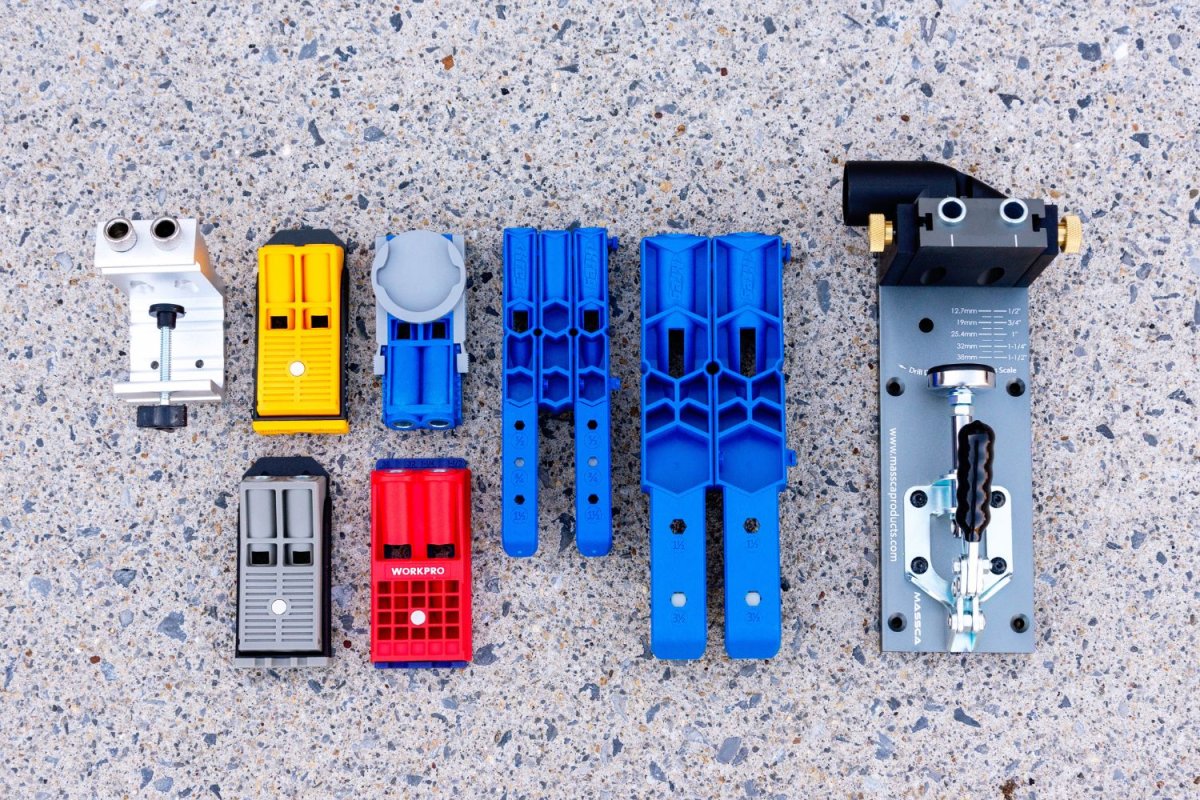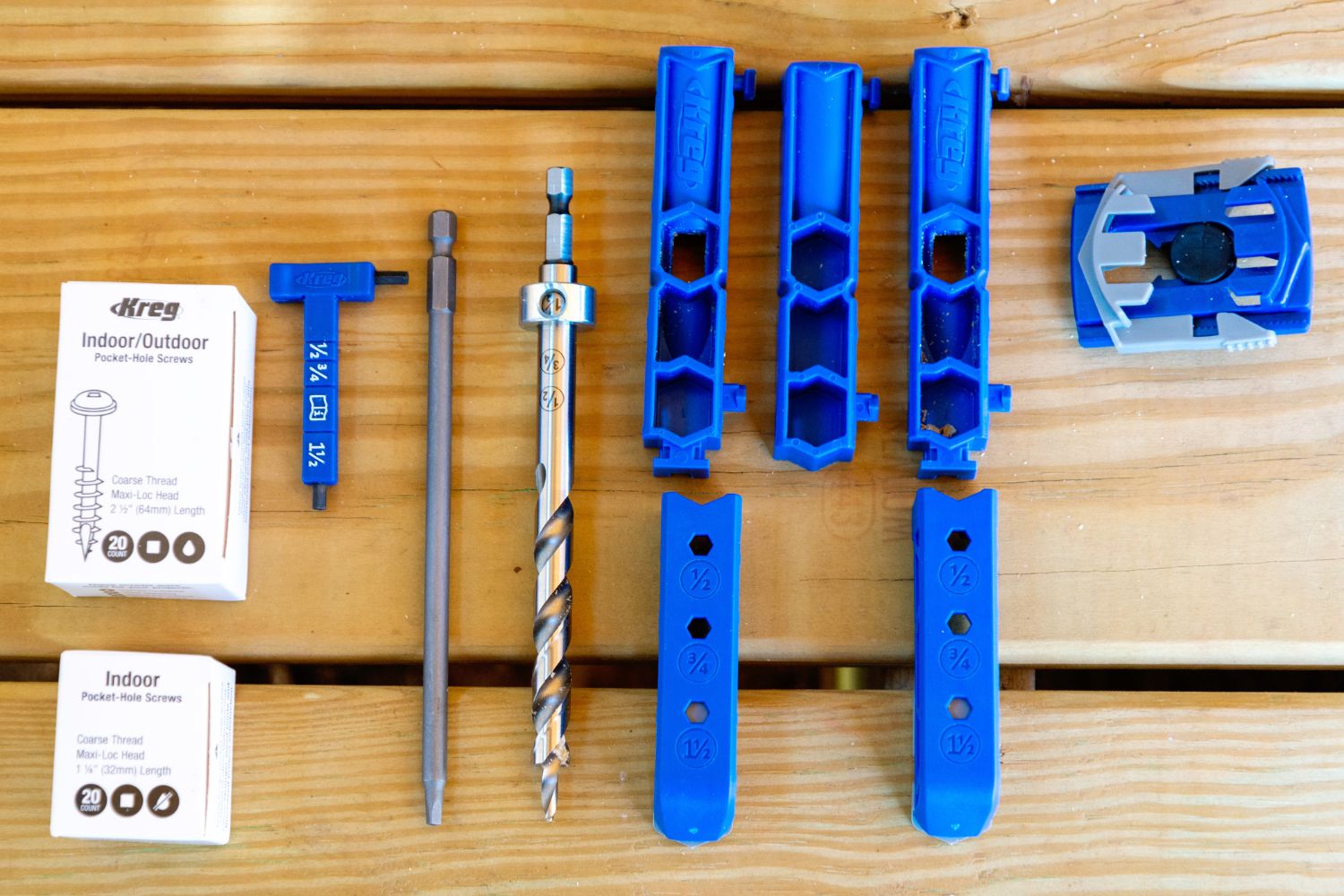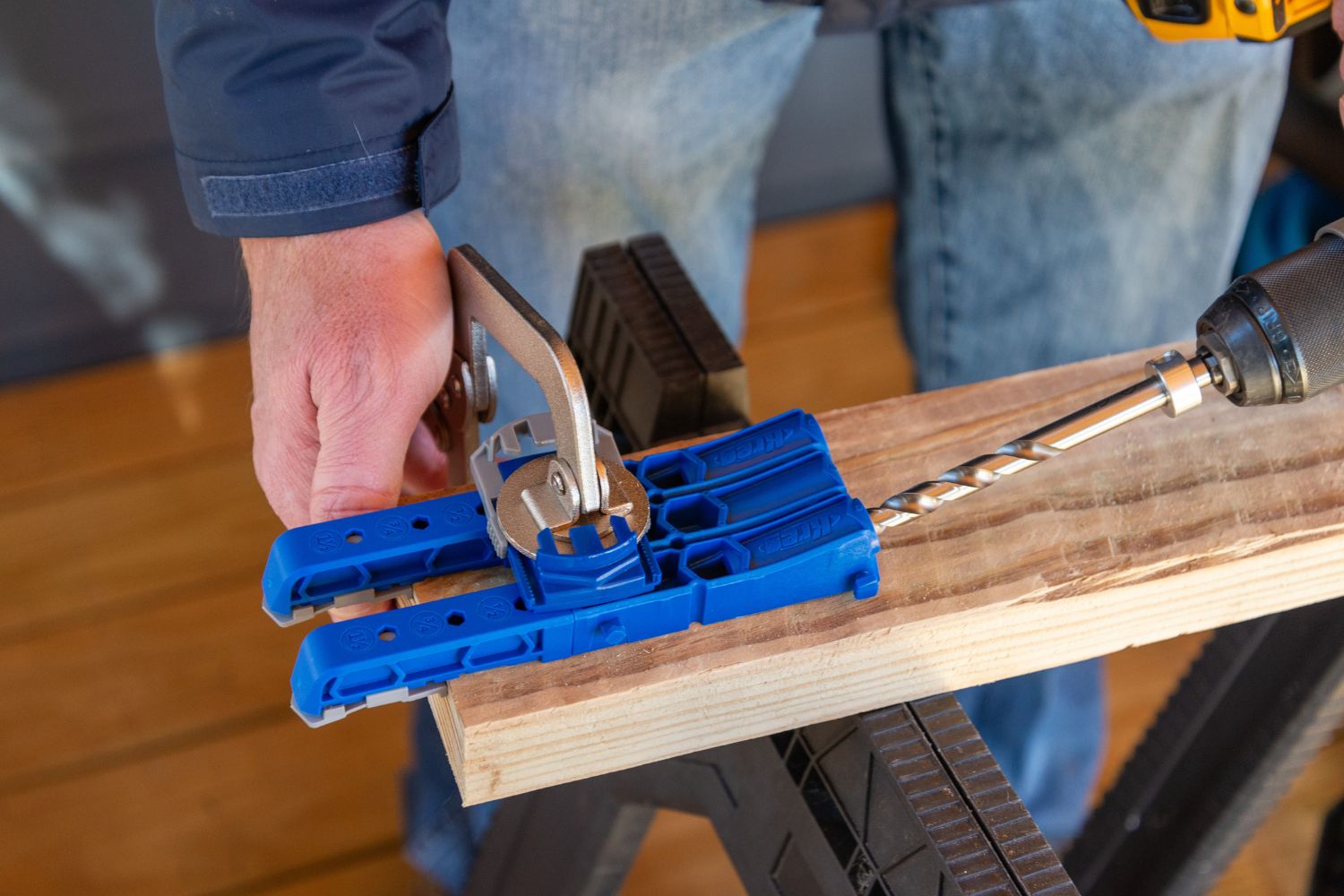

We may earn revenue from the products available on this page and participate in affiliate programs. Learn More ›
Pocket hole jigs make wood joinery faster and easier than traditional methods. Cabinetmakers pioneered the use of these tools for joining the members of cabinet face frames, and it didn’t take long for other woodworkers to recognize their value. Pocket hole joinery is useful anywhere a strong joint is necessary with no visible fasteners on one surface of the project piece. It works for a variety of applications, including edge joining without bar clamps, attaching stair treads and risers to the stringers beneath, attaching chair or table leg rails and braces, joining mitered picture frame joints, and much more.
Kreg Tool Company is an employee-owned business located in Iowa. It patented the first pocket hole jig, based on a U-shaped metal prototype, in 1990. Throughout its first decade, the Kreg Jig rapidly gained popularity as the latest innovation in woodworking and a revolutionary new joinery method. Ongoing product development led to the release of a new design, made of injection-molded plastic, in the early 2000s. This laid the groundwork for the Kreg Pocket Hole Jig 320, R3, and the rest of today’s popular models.
With so many possibilities, it only makes sense for woodworking hobbyists and avid DIYers to search out a versatile pocket hole jig. Upon testing the Kreg Pocket Hole Jig 320 alongside seven competing models, I was impressed by the overall quality of the tool as well as its versatile design. Read on to find out more about this handy tool, and see why we named it the Best Overall Pocket Hole Jig.
Kreg Pocket Hole Jig 320: At a Glance
Rating: 8.7/10

PROS
- Constructed of molded plastic, steel, and rubber for a long working life
- Interlocking parts can be reconfigured for different project applications
- Two drill guides, spacer, adjustable material thickness stops, and clamp pad are included
- Included drill bit features easy-to-read depth labels and see-through depth stop collar
- Parts are well organized in a heavy-duty plastic carry case
CONS
- Odd material thicknesses (those other than ½, ¾, and 1½ inch) are difficult to set up
- In many scenarios this kit requires the user to drill horizontally, which may be less comfortable for extended use
Get the Kreg Pocket Hole Jig 320 at:
What is the Kreg Pocket Hole Jig 320?
The Kreg Pocket Hole Jig 320 (PHJ320) is a simple, affordable, and effective tool that makes wood joinery easier. Once clamped onto a workpiece, the drill guides accurately position the drill bit at a precise 15-degree angle. The included stepped drill bit predrills the wood to guide a screw at the proper angle for a strong mechanical joint, and creates a pocket that conceals the screwhead below the surface of the wood. The PHJ320 works with most softwood, hardwood, composites, and synthetic materials ½ inch to 1½ inches thick.
The PHJ320 kit comes in a durable hard-plastic carry case. The kit includes:
- 2 drill guides
- 2 material thickness stops
- 1 spacer
- Universal clamp pad
- Drill bit with depth stop collar
- Combined hex key and thickness-gauge tool
- Square drive driver bit
- 40 pocket hole screws
I tested this Kreg jig against several other Kreg models, along with popular offerings from Massca, MulWark, Workpro, and General Tools. The PHJ320 earned “Best Overall” in that lineup because of its versatility. It can easily be disassembled and reconfigured for small or large projects. This tool makes a great choice for the widest range of projects.

How easy is the Kreg Pocket Hole Jig 320 to use?
The Kreg PHJ320 is very easy to work with. It comes fully assembled in a well-organized carry case. The jig assembly arrives optimized for drilling two holes in the end of 4-inch-wide lumber. Press and slide the edge alignment stops on the thickness gauges to match the thickness of the workpiece. They click securely into one of three positive lock settings: ½ inch, ¾ inch, or 1½ inch. Insert the clamp pad into any of the holes in the jig body, and clamp the jig onto the workpiece with the edge stops tight to the edge. Use the included hex key to adjust the drill bit depth stop collar and start drilling.
This pocket hole jig is designed with simplicity and functionality in mind. The drill guides, wood thickness gauges, and spacers snap together, and they can be reconfigured for different project needs. No tools are required for these adjustments. The existing kit allows for a single hole, two holes spaced ¾ inch apart (without the spacer), or two holes 1½ inches apart (with the spacer in place). Remove the thickness gauges from the drill guides to work in tight spaces, such as existing inside corners.
The included drill bit features three thickness settings clearly embossed on the shaft and a see-through depth stop collar. Slide the depth stop collar to the appropriate thickness setting and use the included hex key to tighten the set screw. The hex key doubles as a thickness gauge so that users can confirm the project dimensions before setting up the jig.
Is the Kreg Pocket Hole Jig 320 effective for pocket hole joinery?
This tool was very effective for pocket hole joinery. I tested the Kreg PHJ320 on three different sizes of dimensional lumber (1 x 4 hardwood, 5/4 x 6 decking, and 2 x 4), as well as ½-inch plywood and 1 x 6 PVC. In every case, the jig’s nonskid pad, and either a locking C-clamp or bar clamp, ensured tight placement precisely where I needed the holes. Setup took only a few seconds, and the jig held securely while I drilled the holes. It did not require a lot of force from the clamp, and it left nice clean edges on the pocket holes.
For projects that called for repeated placement, the clamp pad conveniently stayed connected to the upper jaw of the clamp, making the process even faster. The clamp pad’s adjustable opening accommodates different clamp types and worked especially well with a locking C-clamp.
As previously noted, the Kreg 320 jig’s versatility placed it ahead of other pocket hole jigs. In its basic configuration, which features two drill guides with three-stop thickness gauges and a spacer between, it is optimized for drilling two well-placed pocket holes in the end of 4-inch-wide lumber—simply adjust the quick stops on the depth gauges to the thickness of the lumber, clamp, and drill.
The removable spacer allowed for the drill guides to be used individually or locked together for closer spacing. Expansion kits are sold separately with additional spacers and drill guides for added functionality and convenience. Removing the depth gauges made it easy to clamp or screw the jig to an existing inside corner, such as a drawer or cabinet frame, for a quick repair without disassembling the wood.

Is the Kreg Pocket Hole Jig 320 good quality?
This tool is thoughtfully made of high-quality, lower-cost materials and designed for years of dependable service. The body of the jig is made of heavy-duty molded plastic with a reinforced honeycomb portion where it is clamped. The adjustable clamp pad includes a rubber plug that fits into the honeycomb openings to diffuse pressure and hold it securely. Thick steel sleeves protect the drill bit guide holes to prevent wear and tear. A nonskid rubber base holds the jig in place with only moderate clamp pressure.
In action, the jig feels strong and secure. When clamped, it grips well and easily resists slipping. When the user removes spacers or adds drill guides, the slip joint connectors lock in place and grip extremely well to prevent any wiggling or play between the pieces.
Is the Kreg Pocket Hole Jig 320 worth the money?
The Kreg Pocket Hole Jig 320 costs about $34 at most retailers, which seems fair. The kit is basically two Kreg 310 jigs ($21 each) plus a ¾-inch spacer. Massca offers a somewhat similar product for around $29, but it lacks Kreg’s easy-to-use thickness stop system. Other toolmakers offer either single drill guides or dual drill guides that cannot be adapted to various widths. What this jig does, it does very well. Few other tools adapt as well.
In addition to its versatility, the PHJ320 also offers solid durability. As mentioned above, the materials are strong, cost-effective, and lightweight. Similarly sized jigs made of cast aluminum offer comparable functionality but cost twice as much, or more. For the combination of functionality and durability, at this price point, the Kreg J320 pocket hole jig is worth the investment.
Should you buy the Kreg Pocket Hole Jig 320?
Woodworkers use pocket hole joints because they quickly and easily make strong connections for a wide array of projects. Although they were originally used for cabinetry face framing and structural frames, pocket joints can be used to join two pieces of wood in nearly any configuration: end to face, end to edge, edge to edge, mitered joints, and more. Because of its compact size and easy adaptability, the Kreg PHJ320 makes a great choice for most projects.
At about the same price as the smaller Kreg R3, slightly more expensive than other fixed- position pocket hole jigs, and much less expensive than most professional models, the Kreg PHJ320 is a really good value. It is well sized to work with small to midsize furniture and repair projects, or to drill pocket holes in plywood, and it can be customized into a variety of configurations for the project at hand. Anyone who is looking for an adaptable, affordable, easy-to-use pocket hole jig will want to consider the Kreg PHJ320.
Where to Buy the Kreg Pocket Hole Jig 320
Get the Kreg Pocket Hole Jig 320 at:
